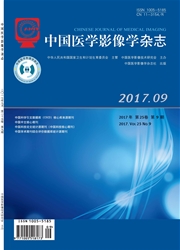

 中文摘要:
中文摘要:
目的 利用灰度差分统计法和游程长矩阵分析MRI上多发性硬化患者病灶区脑白质(LWM)、表现正常脑白质(NAWM)及健康人脑白质(NWM)纹理特征的差异。资料与方法 于26例多发性硬化患者和26例健康对照者的T2WI图像中提取感兴趣区,组成LWM、NAWM和NWM3组样本。利用灰度差分统计法和游程长矩阵提取对比度等8个纹理特征,比较3组样本各纹理特征间的差异。结果 LWM、NAWM、NWM3组样本能量呈递增趋势(F=99.178,P〈0.001),对比度、平均值和熵呈递减趋势(F=45.947、95.637、77.837,P〈0.001);长游程因子和灰度不均匀度因子呈递增趋势(F=11.456、102.747,P〈0.001),短游程因子和游程长不均匀度因子呈递减趋势(F=54.195、51.087,P〈0.001)。3组样本间两两比较,NAWM和NWM组间对比度、长游程因子和灰度不均匀度因子差异无统计学意义(P〉0.05),其余差异均有统计学意义(P〈0.05、P〈0.001)。结论 纹理分析可以揭示多发性硬化患者的隐匿性病变,有助于多发性硬化的早期发现和治疗。
 英文摘要:
英文摘要:
Purpose To analyze the texture characteristics of lesion white matter (LWM) and normal appearing white matter (NAWM) in patients with multiple sclerosis (MS) and normal white matter (NWM) using gray-scale difference method and run-length matrix. Materials and Methods Regions of interest (ROIs) were extracted on T2WI and were classified into LWM, NAWM, and NWM groups for 26 MS patients and 26 normal controls. Eight texture characteristics were extracted using gray-scale difference method and run-length matrix, and the difference of texture characteristics were compared among the three groups. Results There was increased trends of energy, long run emphasis and grey level nonuniformity among LWM, NAWM and NWM group (F=99.178, 11.456, 102.747, P〈0.001), and there were decreased trends of contrast, mean value, entropy, short run emphasis and run length nonuniformity (F=45.947, 95.637, 77.837, 54.195, 51.087, P〈0.001). There was no significant difference for contrast, long run emphasis or graylevel nonuniformity compared between any two groups (P〉0.05), and the others indexes showed statistical difference between any two group (P〈0.05). Conclusion Texture analysis can reveal the occult lesions in MS, and is helpful for the early diagnosis and therapy.
 同期刊论文项目
同期刊论文项目
 同项目期刊论文
同项目期刊论文
 期刊信息
期刊信息
